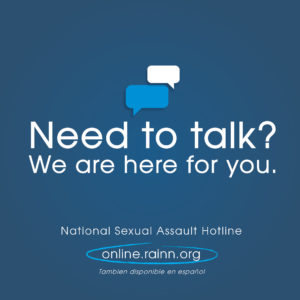One of my favorite pastimes is playing poker — and I had to put my best poker face on the other night when an unexpected flashback snuck up on me.
As survivors of sexual assault, we try very hard to forget about some of the particularly dark experiences we have gone through in our lives. And try as we might, those experiences are always with us and are ready to sneak up on us and offer a reminder of what happened and how it affected us.
The Rape Abuse & Incest National Network (RAINN) defines a flashback this way:
“A flashback is when memories of a past trauma feel as if they are taking place in the current moment. That means it’s possible to feel like the experience of sexual violence is happening all over again. During a flashback it can be difficult to connect with reality. It may even feel like the perpetrator is physically present.
Flashbacks may seem random at first. They can be triggered by fairly ordinary experiences connected with the senses, like the smell of someone’s odor or a particular tone of voice. It’s a normal response to this kind of trauma, and there are steps you can take to help manage the stress of a flashback.”
 In my home town of Wayne, Nebraska, the local Eagles Club hosts a poker league run through a national organization. It’s free to play and there is a core group of about 12-16 people who show up every Wednesday night to play poker, talk about local events and catch up on each other’s lives and families.
In my home town of Wayne, Nebraska, the local Eagles Club hosts a poker league run through a national organization. It’s free to play and there is a core group of about 12-16 people who show up every Wednesday night to play poker, talk about local events and catch up on each other’s lives and families.
I had been sexually assaulted in Newman Grove, Neb., a small town of about 800 people located a little more than an hour southwest of Wayne. The experience took place just a few weeks short of my 10th birthday, an event that, even 42 years later, still pops up now and again — like last week.
I had mentioned that I lived in Newman Grove at one time as we were talking about towns in the area, and a lady at the table said SHE had lived there as well. She graduated from high school around the time our family had lived there and asked me if I remembered any names from when we had lived in the community.
The first one that popped up was the name of my attacker — then a troubled teenage loser, today a convicted sex offender who is on the Nebraska Sex Offender Registry for the rest of his life, thanks to an event that, unexpectedly, came up in conversation with my poker friend.
She had graduated from the local high school a year after my parents moved us out of town to another community. As we were talking about some of the places in the community like the golf course, the local nursing home and the school, she had mentioned that a friend of hers — who was not mentally sound — had been sexually assaulted by my attacker.
As we talked, it became apparent that there was a connection between myself and her friend — one that sent me into flashback that required my best poker face to keep from coming unglued over my chip stack.
Twenty years ago, I had been working as a sports writer at the Norfolk Daily News. This was during a time when the move from traditional cut-and-paste page design to digital page layout with software like Quark Express or Adobe Pagemaker (later Adobe Indesign) was how we put the newspaper together.
Some of our pages were digital, while others were still laid out the “old fashioned” way, so one afternoon as I was waiting for the image processor to spit out the negative of my page, I happened to glance at a paste-up page that contained the “public record” section of the newspaper — court cases, divorces, marriage licenses, arraignments — and started scanning the names to see if there was anybody who I might know.
As it turns out — I did: my attacker had been arraigned on charges of sexual assault of a vulnerable adult.
Twenty years later, my poker friend mentioned this friend of hers and the connection, and it all came together . . . this friend of hers was attacked by my attacker some 20 years later, and could have faced a then-maximum sentence of five years.
After talking with the county attorney, it didn’t sound like he would face anywhere near that length of a stay in the state penitentiary. I asked if there was anything I could do to help him get the maximum penalty, and he had a suggestion — write the judge a letter, explain my connection to the case and tell my story.
In a three-page letter to the judge, I explained why I had an interest in this case and proceeded to tell him how the defendant had sexually assaulted me and threatened to kill me if I ever told anybody about it. The nightmares I had and the impact it had on my life was something I didn’t want somebody else to have to go through.
Amazingly, that letter helped our attacker get EXACTLY the maximum sentence allowed by law at the time, along with a lifetime membership on the state’s Sex Offender Registry (here is his entry, in case you’re wondering). It was justice delayed, in my case anyway, but the friend of my poker friend and I both got it and he wound up with a much longer stay at the Nebraska State Penitentiary than he no doubt was counting on.
I was able to reset myself as my friend and I talked about my experience, and thankfully my ability to put on a good poker face really minimized the potential chaos that might have happened had I not recognized what I was feeling right away.
You may not play poker, but you can minimize the impact of a flashback by doing these four things:
1. Tell yourself that you’re having a flashback — Remember that the actual event is in the past and you are a survivor of it. It’s over, you’re still here. Everything is OK.
2. Use your senses to return to the present — What do you see, smell, hear, taste or feel around you right now? I touched the felt of the poker table, shuffled my poker chips, talked to the other players at the table, took a sip of Mountain Dew and kept reminding myself where I was and what I was doing, using my five senses.
3. Breeeeeeeathe — take some slow, deep breaths to calm yourself down. A panic attack or a flashback can cause the body to act abnormally, so make sure you’re taking some good, deep breaths to get more oxygen in your body and help calm you and relieve the stress of the flashback.
4. Feel safe and BE safe — For me, staying in the room and trying to distract myself by talking with the other players helped me out. Maybe you just need to go home, sit quietly or meditate, read a book . . . find something to help you feel safe and take your mind off what caused the flashback to begin with. Remember — what happened has happened. It is over. You’re OK.
Flashbacks can be triggered by almost anything, so the sooner you figure out what your triggers are, the easier it will be to manage your emotions and ride through — or even around — those trigger moments and minimize the number and severity of flashbacks you have.
If you are seeing a mental health professional, talk with them about your experience and ask for their help. There are plenty of tools available to help you — to borrow a poker phrase — go “all in” and get through a flashback successfully. You can also call the National Sexual Assault Hotline at 800.656.HOPE (4673) chat with RAINN online at online.rainn.org.

 In a crazy year when they very easily could have honored a loudmouthed world leader, a communist lunatic or an unpatriotic out-of-work football player, Time Magazine instead chose to honor not just an individual but a deserving group of brave people who are dragging an unspeakable crime out of the darkness and giving the abusive power structure in this country a long-overdue kick in the teeth.
In a crazy year when they very easily could have honored a loudmouthed world leader, a communist lunatic or an unpatriotic out-of-work football player, Time Magazine instead chose to honor not just an individual but a deserving group of brave people who are dragging an unspeakable crime out of the darkness and giving the abusive power structure in this country a long-overdue kick in the teeth.